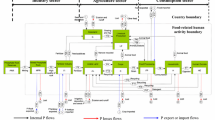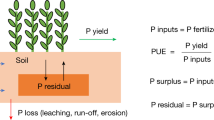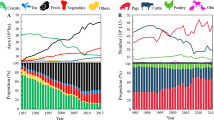Abstract
China has become the largest mineral phosphorus (P) fertilizer consumer in the world, but current use is not sustainable. Here, we report on a quantitative analysis of the P use and losses in the food production–consumption chain and of their relationships with socio-economic indicators for the years 1950–2010. Pathways to a more sustainable P use in 2030 were explored through scenario analyses, using the Nutrient flows in Food chains, Environment and Resource use model. Non-linear relationships were observed between changes in P use and changes in gross domestic production (GDP), suggesting a decoupling of P use from the main economic driver. More or less linear relationships were observed between changes in P use and changes in the percentages of vegetable and fruit and animal derived food in human diets. Total P losses increased from 0.2 Tg in 1950 to 3.1 Tg in 2010, while P use efficiency in the food chain decreased from 35 % in 1950 to 6 % in 2010. Our estimates suggest that 79 Tg P has accumulated in agricultural soils, 16 Tg P accumulated in landfill, and 48 Tg P has leached or has been discharged to water bodies during the past 60 years. Most of the accumulation and discharges took place in the last 10 years. We analyzed five options for increasing P use efficiency in the food chain by 2030, i.e., balanced P fertilization in crop production, precision animal P feeding, improved manure management, diet changes, and the integration of these four options. The integral adoption of these four options will increase P use efficiency in the food chain from 6 % in 2010 to 26 % in 2030. Total mineral P fertilizer use will decrease by 69 % and P losses by 68 % relative to the business as usual scenario. In conclusion, current P fertilizer use and losses are coupled to dietary choices, but have become decoupled from GDP. Further decoupling may occur when P use is defined by science-based P requirements for crops, animals and humans.







Similar content being viewed by others
References
Bai Z, Li H, Yang X, Zhou B, Shi X, Wang B, Li D, Shen J, Chen Q, Qin W, Oenema O, Zhang F (2013) The critical soil P levels for crop yield, soil fertility and environmental safety in different soil types. Plant Soil 372(1–2):27–37
Carpenter SR (2008) Phosphorus control is critical to mitigating eutrophication. PNAS 105:11039–11040
Carpenter SR, Bennett EM (2011) Reconsideration of the planetary boundary for phosphorus. Environ Res Lett 6(1):014009
Carstensen J, Andersen JH, Gustafsson BG, Conley DJ (2014) Deoxygenation of the Baltic Sea during the last century. PNAS 111(15):5628–5633
Chen X, Cui Z, Fan M, Vitousek P, Zhao M, Ma W, Wang Z, Zhang W, Yan X, Yang J, Deng X, Gao Q, Zhang Q, Guo S, Ren J, Li S, Ye Y, Wang Z, Huang J, Tang Q, Sun Y, Peng X, Zhang J, He M, Zhu Y, Xue J, Wang G, Wu L, An N, Wu L, Ma L, Zhang W, Zhang F (2014) Producing more grain with lower environmental costs. Nature 514(7523):486–489
Conley DJ, Paerl HW, Howarth RW, Boesch DF, Seitzinger SP, Havens KE, Lancelot C, Likens GE (2009) Controlling eutrophication: nitrogen and phosphorus. Science 323(5917):1014–1015
Cordell D, Drangert JO, White S (2009) The story of phosphorus: global food security and food for thought. Glob Environ Change 19(2):292–305
Cordell D, Rosemarin A, Schröder JJ, Smit AL (2011) Towards global phosphorus security: a systems framework for phosphorus recovery and reuse options. Chemosphere 84(6):747–758
Desmidt E, Ghyselbrecht K, Zhang Y, Pinoy L, Van der Bruggen B, Verstraete W, Rabaey K, Meesschaert B (2015) Global phosphorus scarcity and full-scale P-recovery techniques: a review. Crit Rev Environ Sci Technol 45(4):336–384
FAO (2014) FAOSTAT. http://faostat.fao.org/site/291/default.aspx. Accessed 2014
Godfray HCJ, Beddington JR, Crute IR et al (2010) Food security: the challenge of feeding 9 billion people. Science 327(5967):812–818
Li H, Huang G, Meng Q, Ma L, Yuan L, Wang F, Zhang W, Cui Z, Shen J, Chen X, Jiang R, Zhang F (2011) Integrated soil and plant phosphorus management for crop and environment in China. A review. Plant Soil 349(1–2):157–167
Li Y, Zhang W, Ma L, Huang G, Oenema O, Zhang F, Dou Z (2013) An analysis of China’s fertilizer policies: impacts on the industry, food security, and the environment. J Environ Qual 42(4):972–981
Ma L, Ma WQ, Velthof GL, Wang FH, Qin W, Zhang FS, Oenema O (2010) Modeling nutrient flows in the food chain of China. J Environ Qual 39(4):1279–1289
Ma D, Hu S, Chen D, Li Y (2012a) Substance flow analysis as a tool for the elucidation of anthropogenic phosphorus metabolism in China. J Clean Prod 29:188–198
Ma L, Velthof GL, Wang FH, Qin W, Zhang WF, Liu Z, Zhang Y, Wei J, Lesschen JP, Ma WQ, Oenema O, Zhang F (2012b) Nitrogen and phosphorus use efficiencies and losses in the food chain in China at regional scales in 1980 and 2005. Sci Total Environ 434:51–61
Ma L, Wang F, Zhang W, Ma W, Velthof G, Qin W, Oenema O, Zhang F (2013a) Environmental assessment of management options for nutrient flows in the food chain in China. Environ Sci Technol 47(13):7260–7268
Ma L, Zhang WF, Ma WQ, Velthof GL, Oenema O, Zhang FS (2013b) An analysis of developments and challenges in nutrient management in China. J Environ Qual 42(4):962–971
MacDonald GK, Bennett EM, Potter PA, Ramankutty N (2011) Agronomic phosphorus imbalances across the world’s croplands. PNAS 108(7):3086–3091
Metson GS, Bennett EM, Elser JJ (2012) The role of diet in phosphorus demand. Environ Res Lett 7(4):044043
MOA (Minister of Agriculture) (2009) New China’s agricultural statistics for 60 years. China Statistics Press, Beijing
MOA (Minister of Agriculture) (2013) China husbandry yearbook. China Statistics Press, Beijing
MOA (Minister of Agriculture) (2015) http://www.moa.gov.cn/zwllm/tzgg/tz/201503/t20150318_4444765.htm. Accessed 2015.03. (In Chinese)
NBSC (National Bureau of Statistics of China) (2009) China Compendium of Statistic 1949–2008. China Statistics Press, Beijing
NBSC (National Bureau of Statistics of China) (2013) China statistic yearbook. China Statistics Press, Beijing
Oenema O (2004) Governmental policies and measures regulating nitrogen and phosphorus from animal manure in European agriculture. J Anim Sci 82(13_suppl):E196–E206
Ott C, Rechberger H (2012) The European phosphorus balance. Resour Conserv Recycl 60:159–172
Richardson AE (2009) Regulating the phosphorus nutrition of plants: molecular biology meeting agronomic needs. Plant Soil 322:17–24
Schmid NTS, Bader HP, Scheidegger R, Lohm U (2008) The flow of phosphorus in food production and consumption—Linköping, Sweden, 1870–2000. Sci Total Environ 396(2):111–120
Sharpley AN, Beegle D (2001) Managing phosphorus for agriculture and the environment. College of Agricultural Sciences, The Pennsylvania State University, University Park, PA
Smil V (2000) Phosphorus in the environment: natural flows and human interferences. Annu Rev Energy Environ 25:53–88
Steffen W, Richardson K, Rockström J, Cornell SE, Fetzer I, Bennett EM, Biggs R, Carpenter SR, de Vires W, de Wit CA, Folke C, Gerten D, Heinke J, Mace GM, Persson LM, Ramanathan V, Reyers B, Sörlin S (2015) Planetary boundaries: guiding human development on a changing planet. Science 347(6223):1259855
Suh S, Yee S (2011) Phosphorus use-efficiency of agriculture and food system in the US. Chemosphere 84(6):806–813
Syers JK, Johnston AE, Curtin D (2008) Efficiency of soil and fertiliser phosphorus use: reconciling changing concepts of soil phosphorus behaviour with agronomic information. Food and Agriculture Organization of the United Nations Report, Rome
Tilman D, Clark M (2014) Global diets link environmental sustainability and human health. Nature 515(7528):518–522
UN (United Nations) (2010) World population prospects: the 2008 revision population database
UNDP (2009) China and a sustainable future: towards a low carbon economy and society, china human development report 2009/10. China Translation & Publishing Corporation: Beijing, 2010
van Drecht G, Bouwman AF, Harrison J, Knoop JM (2009) Global nitrogen and phosphate in urban wastewater for the period 1970 to 2050. Global Biogeochem Cycles 23(4)
Wang F, Dou Z, Ma L, Ma W, Sims JT, Zhang F (2010) Nitrogen mass flow in China’s animal production system and environmental implications. J Environ Qual 39(5):1537–1544
Wang F, Sims JT, Ma L, Ma W, Dou Z, Zhang F (2011) The phosphorus footprint of China’s food chain: implications for food security, natural resource management, and environmental quality. J Environ Qual 40(4):1081–1089
Withers PJA, Van Dijk K, Neset TS (2015) A 5R stewardship to tackle global phosphorus inefficiency: the case of Europe. Ambio 44(2):193–206
Wu H, Yuan Z, Gao L, Zhang L, Zhang Y (2015) Life-cycle phosphorus management of the crop production–consumption system in China, 1980–2012. Sci Total Environ 502:706–721
Yan Z, Liu P, Li Y, Ma L, Alva A, Dou Z, Chen Q, Zhang F (2013) Phosphorus in China’s intensive vegetable production systems: over fertilization, soil enrichment, and environmental implications. J Environ Qual 42(4):982–989
Zhang W, Ma W, Ji Y, Fan M, Oenema O, Zhang F (2008) Efficiency, economics, and environmental implications of phosphorus resource use and the fertilizer industry in China. Nutr Cycl Agroecosyst 80(2):131–144
Acknowledgments
This work was financially supported by the Chinese National Basic Research Program (2015CB150405) and the Hundred Talent Program of the Chinese Academy of Sciences. The authors would like to extend special thanks to Thomas Nesme and two anonymous reviewers of their constructive comments and suggestions in improving the quality of this paper.
Author information
Authors and Affiliations
Corresponding author
Electronic supplementary material
Below is the link to the electronic supplementary material.
Rights and permissions
About this article
Cite this article
Bai, Z., Ma, L., Ma, W. et al. Changes in phosphorus use and losses in the food chain of China during 1950–2010 and forecasts for 2030. Nutr Cycl Agroecosyst 104, 361–372 (2016). https://doi.org/10.1007/s10705-015-9737-y
Received:
Accepted:
Published:
Issue Date:
DOI: https://doi.org/10.1007/s10705-015-9737-y




